Standing at the entrance of an abandoned mine shaft near Frontenac Provincial Park, Tom adjusts his helmet light while Julie double-checks our safety gear. The crisp autumn air carries whispers of adventure, reminding us why exploring the underground wonders of Ontario has become our shared passion. Today’s expedition combines our love for hiking through Ontario’s rugged wilderness with the thrill of discovering historical mining sites that once fueled the region’s economic boom.
Like many weekend adventurers, we’ve learned that mine exploration demands equal parts preparation and respect for nature’s raw beauty. Our backpacks carry essential safety equipment – from backup lights and first-aid supplies to detailed topographical maps marking both the hiking trails and documented mine openings. Yet it’s the stories these abandoned mines tell – of ambitious prospectors, determined miners, and the communities they built – that truly capture our imagination and keep drawing us back to these hidden historical treasures.
As experienced hikers turned amateur mine explorers, we’ve discovered that the real adventure lies in finding the perfect balance between challenging ourselves and maintaining absolute safety. Each expedition teaches us something new about Ontario’s rich mining heritage, while the surrounding trails offer breathtaking views that remind us why combining hiking with mine exploration creates an unmatched outdoor experience.
Preparing for Underground Adventure
Safety First: Required Gear and Equipment
Before heading into any mine exploration adventure, having the right essential safety equipment is non-negotiable. Tom and Julie always stress this golden rule: never enter a mine without proper gear, no matter how brief the visit might be.
Start with a robust helmet equipped with a mounted LED light – and always pack backup batteries! A secondary handheld flashlight is crucial too. We learned this the hard way when Julie’s headlamp died halfway through our first exploration. Sturdy boots with good ankle support and grip are essential, as mine floors can be slippery and uneven.
Your backpack should contain:
– First aid kit with emergency blanket
– Fully charged cell phone (though reception may be limited)
– Compass and detailed mine maps
– Emergency whistle
– Water and high-energy snacks
– Warm, moisture-wicking layers
– Heavy-duty gloves
– Dust mask or respirator
– Basic tool kit
Pro tip: We always bring bright marking tape to track our route, though we’re careful to remove it when leaving. Remember to wear bright or reflective clothing – it makes a huge difference when taking photos or if you need to spot fellow explorers in the dim light. And never forget to tell someone reliable about your plans and expected return time!
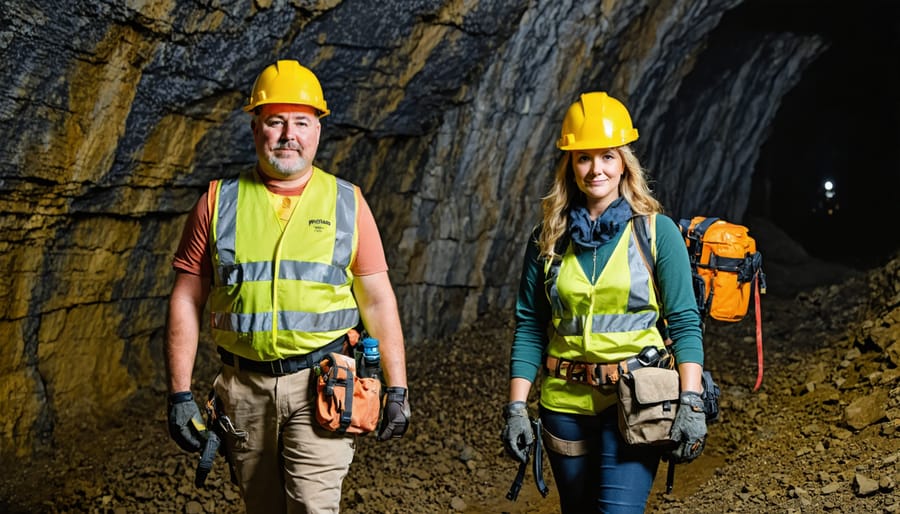
Permits and Permissions
Before heading out on your mine exploration adventure with Tom and Julie, it’s crucial to secure the proper permits and permissions. In Ontario, accessing abandoned mines requires explicit permission from the property owners, whether private individuals or mining companies. Tom and Julie always emphasize starting your planning at least two months before your intended visit date.
For the specific mine sites in the Sudbury region, you’ll need to contact the local mining authority and submit a formal request. The basic exploration permit costs around $50 per person and includes a mandatory safety briefing. Some locations may require additional permissions from local Indigenous communities if the sites are on or near traditional territories.
Our insider tip: Tom maintains excellent relationships with local property owners and can often help streamline the permit process. However, it’s essential to respect their protocols and timelines. While hiking trails around the mines are generally accessible with standard park permits, entering any mine openings without proper documentation can result in hefty fines.
Remember to carry your permits with you at all times during your exploration. Julie suggests taking photos of your documents as backups on your phone, but always bring the original copies. For groups larger than four people, special group permits may be required, and these often need to be arranged at least three months in advance.
Keep in mind that some areas may have seasonal restrictions, particularly during wildlife breeding seasons or heavy rainfall periods. Always check current conditions and permit requirements before setting out.
Journey Into the Earth
The Initial Descent
The late afternoon sun cast long shadows as we approached the mine entrance, our headlamps already secured and checked twice. Tom, our experienced guide, paused at the threshold, giving us a moment to take in the historic significance of what we were about to explore. The weathered timber frame around the entrance told stories of Ontario’s rich mining heritage, while the cool air flowing from the darkness hinted at the adventure ahead.
“Watch your step here,” Julie advised, pointing out the initial gradient change. The first few meters were relatively straightforward, with well-maintained wooden steps leading us into the earth. The temperature dropped noticeably as we descended, and the familiar scent of damp stone and mineral-rich earth filled our nostrils. Our headlamp beams danced across the tunnel walls, revealing glittering veins of quartz and the occasional timber support beam.
The transition from daylight to complete darkness happened gradually, but it still took our eyes several minutes to adjust. Tom shared fascinating bits of history as we carefully made our way down, pointing out original drill marks in the rock face and explaining how miners would have navigated these same passages decades ago.
The sound of our footsteps echoed softly, accompanied by the gentle drip of water from somewhere in the darkness ahead. Despite being underground, the main tunnel was surprisingly spacious, allowing us to walk comfortably while maintaining awareness of our surroundings.
Underground Wonders
As we ventured deeper into the mine, our headlamps illuminated a mesmerizing underground world that would captivate even seasoned rock climbing enthusiasts. The walls sparkled with traces of mica and quartz, creating a natural light show that danced across the rocky surfaces. Tom pointed out the remarkable stalactites forming along the ceiling, their crystalline structures slowly built up over decades of mineral-rich water seepage.
We discovered fascinating remnants of the mining era: old railroad ties still embedded in the ground, rusted ore cart tracks disappearing into shadowy tunnels, and even some preserved wooden support beams that told silent stories of the miners who once worked here. Julie’s expertise came in handy as she explained how different rock formations indicated various mineral deposits, from the distinctive purple-tinged amethyst veins to the gleaming bands of silver ore.
The most impressive sight was a massive chamber where the miners had followed a particularly rich vein. The ceiling soared nearly thirty feet high, creating a cathedral-like space underground. Here, we found well-preserved drill marks in the walls and even some old mining tools that had been left behind, now serving as an impromptu museum of industrial heritage. The cool, damp air carried the earthy scent of mineral-rich soil, adding to the authentic underground experience.
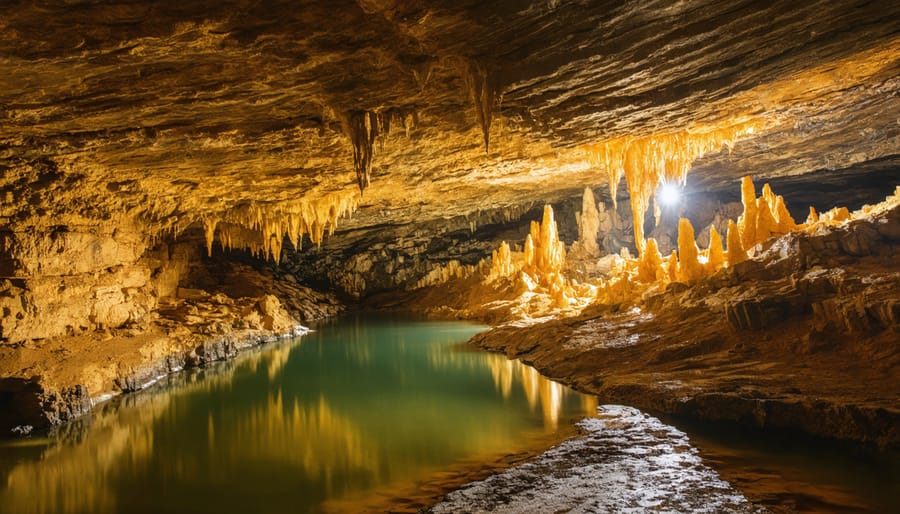
Navigating the Tunnels
As we ventured deeper into the mine, Tom led the way with his helmet light casting long shadows on the rough-hewn walls. The main tunnel stretched before us like an underground highway, its width allowing comfortable passage for our small group. Julie pointed out the old rail tracks beneath our feet, now partially buried under years of mineral deposits and dust.
The air grew noticeably cooler as we progressed, and the sound of water dripping created an otherworldly echo. Tom showed us how to identify different tunnel types – some were carefully reinforced with timber supports, while others displayed bare rock faces with glittering mineral seams.
We discovered smaller side passages branching off the main tunnel, each telling its own story of Ontario’s mining heritage. One particularly interesting chamber revealed old mining equipment, frozen in time like a museum display. Julie explained how miners would have used these tools, bringing the space’s history to life.
The most challenging section was a narrower passage that required us to duck and weave around protruding rock formations. Tom’s expert guidance helped us navigate these tighter spots safely, teaching us to always maintain three points of contact when moving through uneven terrain.
The journey through the tunnels was like reading a geological storybook, with each layer of rock and mineral deposit adding another chapter to the narrative.
Above Ground: The Hiking Component
Historic Mining Trail Network
The historic mining trails in this area form an intricate web of paths that tell the story of Ontario’s rich mining heritage. These interconnected routes, originally carved out by miners in the early 1900s, now serve as fascinating hiking paths that link various abandoned mine sites, offering explorers a unique blend of history and natural beauty.
Tom and Julie’s favorite route follows the old ore cart tracks, which wind through dense forest and connect three major mining operations from the region’s heyday. The main trail stretches about 8 kilometers, with several shorter loops branching off to viewpoints and hidden mine entrances. What makes this network special is how it naturally guides hikers through different chapters of mining history, from the earliest hand-dug prospects to more modern operations.
The trails are well-maintained by local conservation groups, with clear markers and interpretive signs at key points. You’ll find convenient rest areas at former mining camps, where original equipment and building foundations remain. These spots make perfect picnic locations, especially the old foreman’s lookout which offers spectacular views of the surrounding wilderness.
For new visitors, we recommend starting with the 3-kilometer Heritage Loop, which provides an excellent introduction to the area’s mining history while staying on easier terrain. More experienced hikers can tackle the full network, which includes some challenging sections with moderate elevation gains. During spring and fall, watch for seasonal waterfalls near the old water-powered stamp mill site – they’re absolutely gorgeous and perfect for photos.
Remember to pick up a trail map at the visitor center, as some of the lesser-used connecting paths can be tricky to navigate without proper guidance.
Surface Structures and Artifacts
As we approached the mine site with Tom and Julie, remnants of Ontario’s rich mining heritage emerged from the surrounding forest. The rusted ore cart tracks, partially hidden beneath fallen leaves, led us to what Tom explained was once a bustling mining operation. Near the main entrance, we discovered a collection of weathered timber supports and the foundations of what used to be the mine office.
Julie pointed out several historic mining sites scattered across the area, including the remains of an old processing plant where minerals were once sorted and prepared for transport. The most impressive surface structure was the headframe – a towering steel framework that once housed the elevator system used to transport miners and materials in and out of the shaft.
What fascinated us most were the small artifacts that told stories of daily mining life: scattered pieces of old equipment, worn tools, and even fragments of miners’ lunch pails. Tom showed us how to spot tailings piles – the accumulated waste rock from mining operations – which now support unique plant species adapted to the mineral-rich soil.
Nature has begun to reclaim many of these structures, with moss carpeting the concrete foundations and small trees growing through gaps in the remaining walls. While exploring, we made sure to follow Tom and Julie’s guidance about respecting these historical remnants and maintaining a safe distance from any unstable structures. Their knowledge helped us appreciate both the industrial heritage and the natural transformation of this remarkable site.
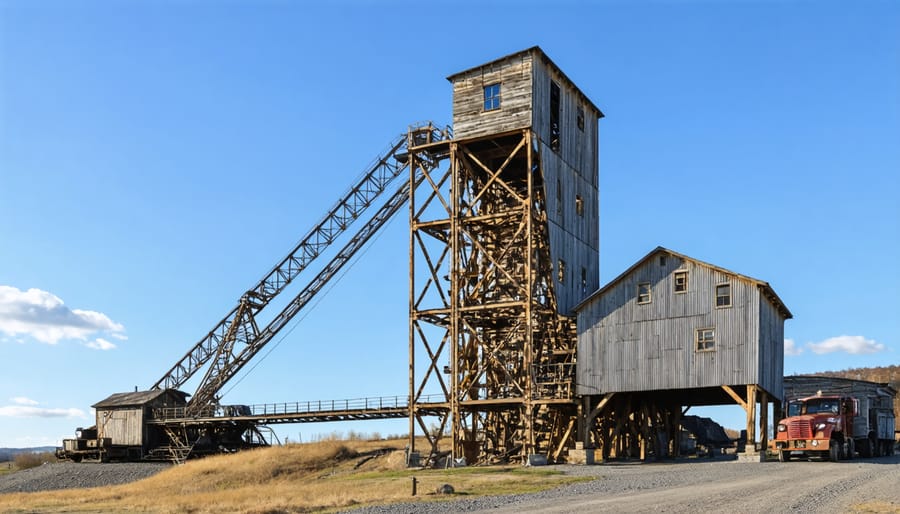
As we wrap up our adventure with Tom and Julie, it’s clear that combining mine exploration with hiking offers a unique perspective on Ontario’s rich mining heritage and natural beauty. To make the most of your own experience, remember to always check weather conditions before heading out and pack essential safety gear, including a reliable headlamp with backup batteries.
The best time to visit these historic mining trails is during late spring or early fall when the temperatures are moderate and the trails are less crowded. Don’t forget to bring plenty of water, high-energy snacks, and wear layers of moisture-wicking clothing – the temperature inside abandoned mines can be significantly cooler than outside.
Photography enthusiasts should bring a tripod for capturing the interesting geological formations and historic mining equipment. However, always prioritize safety over getting the perfect shot. Remember to stay on marked paths and never venture into restricted areas.
For those inspired by our journey, consider joining local hiking groups or guided mine tours to learn from experienced explorers. Many communities near historic mining sites offer seasonal guided walks that combine historical insights with outdoor recreation.
One final tip from Tom and Julie: take time to appreciate both the industrial heritage and the recovering natural environment. The contrast between the two tells a fascinating story of our province’s evolution from resource extraction to conservation and sustainable tourism.
Remember to leave no trace, respect posted signs, and share your discoveries responsibly on social media to help preserve these unique locations for future adventurers. Happy exploring!

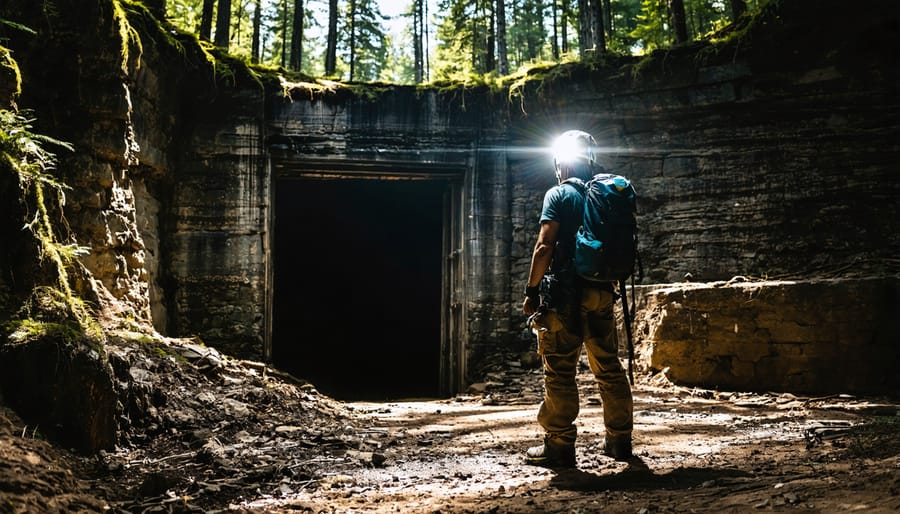

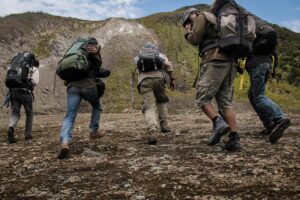




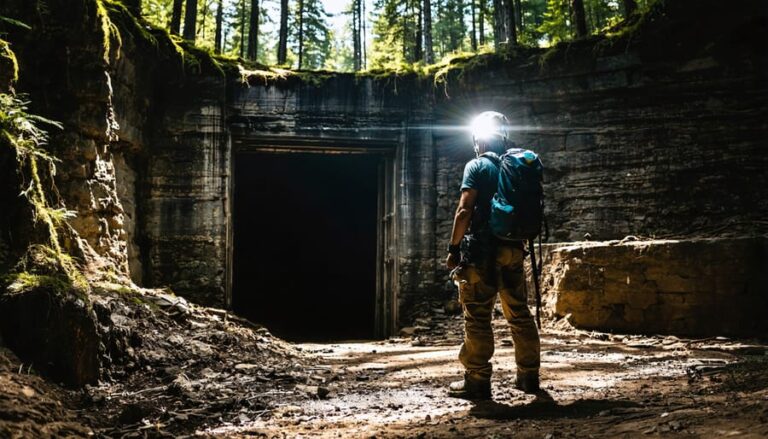





+ There are no comments
Add yours